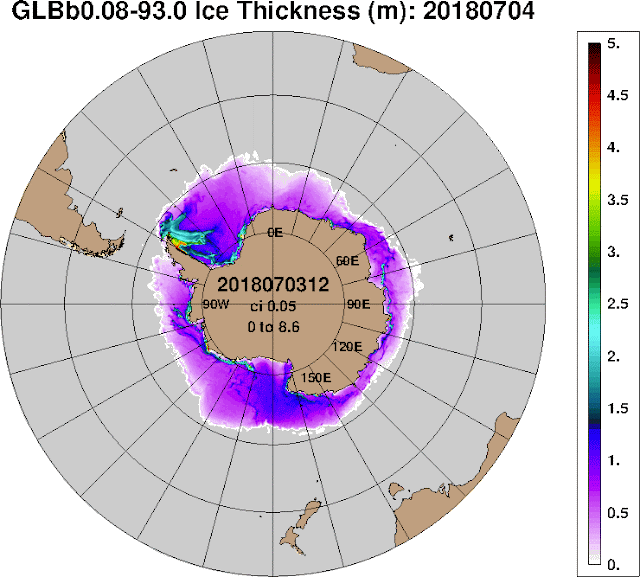Because
Antarctic ice is mainly first-year ice, which is not as thick as
multiyear ice, it is generally less than a few meters thick.
Snowfall and flooding of the ice can thicken it substantially, and
the layer structure of Antarctic ice is often quite complex.
SHOCKING
data from the US Navy on Antarctic sea ice thickness
I
am not easily shocked these days but I must admit that the following
data from the august US Navy and NSIDC shocked the pants off me!
I
cannot claim credit for finding this. Margo of Margo’s Healing
Place spent quite a bit of time searching for gif’s of Arctic sea
ice thickness and in the process found this.
It
is deep winter in Antarctica and the sea ice is supposed to be thick
– not 1 meter thick as indicated here.
If you compare sea ice thickness with sea ice concentration the implications are shocking.
If you compare sea ice thickness with sea ice concentration the implications are shocking.
According to the academic from NZ’s Otago University in an interview from a year ago “Antarctic sea ice not decreasing like Arctic sea ice” and scientists do not know what the thickness of the ice is.
How does that square with this data?
Someone is being a little economic with the truth.
Perhaps the University of Otago has not caught up with the satellite age yet?
My comments at the time:
Sometimes when I
switch on Radio
New Zealand I have to pinch myself and ask whether they (or
I) exist in some parallel universe.
I
have been covering news from Antarctica for five years and so you can
imagine my surprise when I heard an item advertised on “why the
Arctic ice is melting and Antarctica is not”
My
surprise disappeard when I heard the academic describe how she gets
all her information from computer models inputting all the
information.
No
wonder she seems so out of touch and allows Radio New Zealand give
the impression that sea ice in Antarctica is melting. She must have
been so busy in front of her computer that she has not noticed the
information about disappearing sea ice from NASA and others over the
summer.
One
thing that struck me is Antarctica has no Peter Wadhams who has been
observing the thickness of Arctic ice from a submarine over many
years.
They
do not appear to have a reliable method of measuring Antarctic ice
thickness – so they are attempting to catch up – using a DC3!
Of
course going back 3 years the Arctic ice extent was at a record. That
was when the Russian ship got stuck in the ice in the middle of
summer,something that delighted the deniers.
She
seems to have missed out on research that indicates that Antarctic
ice is melting from below.
We
all know what she points out about the differences between the Arctic
and Antarctica - that Antarctica is and surrounded by sea while the
Arctic is sea surrounded by land, so the sea ice behaves quite
different.
Kathryn
Ryan talks to the University of Otago's sea-ice expert Professor Pat
Langhorne. Sea-ice physics is a relatively new discipline, and there
are many important questions that are still unanswered, such as: why
is Antarctic sea ice not decreasing like Arctic sea ice? The answers
to these questions are believed to be crucial to understanding the
effects climate change is having on different parts of the continent.
Who is, and who isn't speaking the truth?
P.S.







Ive been watching the SST for Antarctica all winter(Antarctic's winter. There is no way the the ice cannot be melting.The temps are constantly above the freezing point(28.4 for salt water).And with little precipitation and frightening air temps far above normal, are these people brain dead ???
ReplyDeleteSome direct measurements of the solar angle of obliquity indicate the earth is tilting towards the sun at the north pole. A wobble has developed which transits from just under 13 degrees to 19 degrees over about 3 weeks.
ReplyDeleteTwo different means of measuring are used and they agree. The historical method of a vertical pole and its shortest shadow using trig with the poles height, and a handheld instrument called an Abney that has a vernier allowing resolution to 10 minutes.
From 7/17 to about 8/8/18 the suns angle went from about 13 degrees to 19 degrees.
Depending on the path of the wobble, circular or eliptical, in another 3 weeks if it is circular, the angle should start to decrease again as the sun goes back towards the zenith. Then for 3 weeks it will remain at the high angle of just under 13 degrees. If the wobble is eliptical opposing sides of the cycles will be less that the parts perpindicular to them. If circular the full rotation will be around 12 weeks.
This would provide reason for less melt in Antartica than the north pole and explain heatwave in the northern hemisphere. Of course abberations in the jet stream will shove hot and cold air into areas they normally are not found.